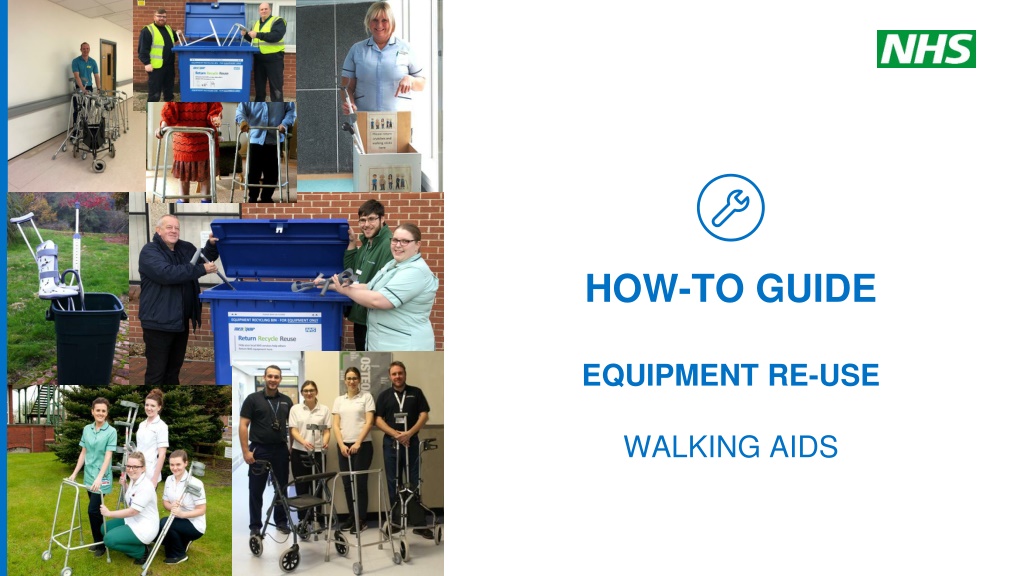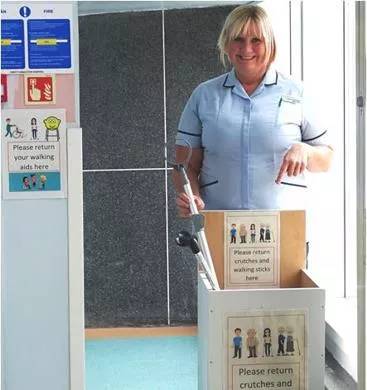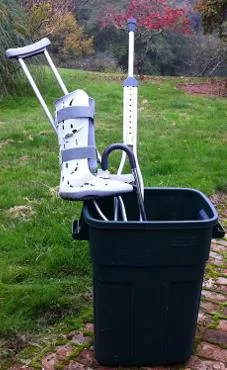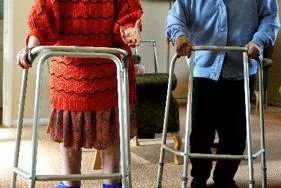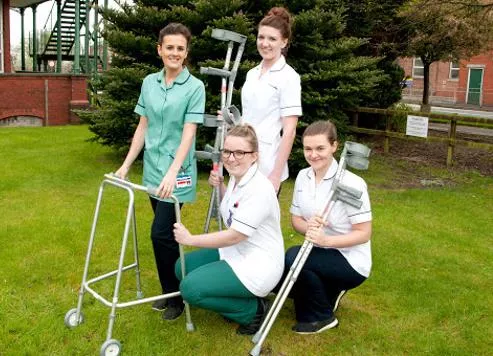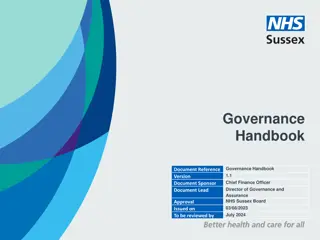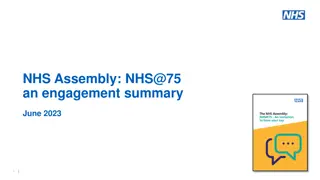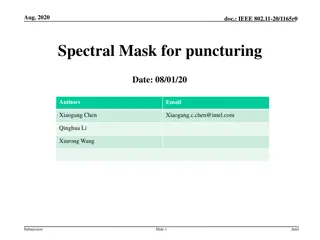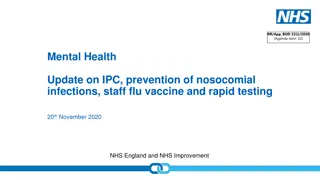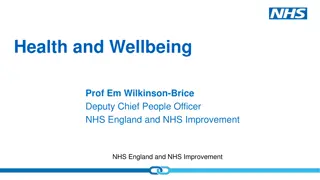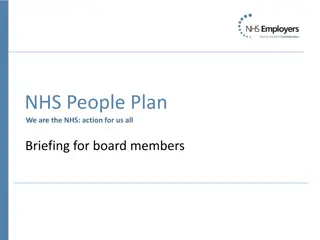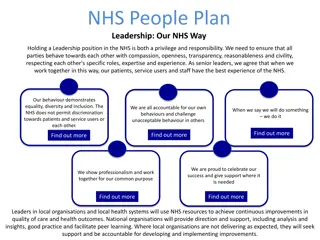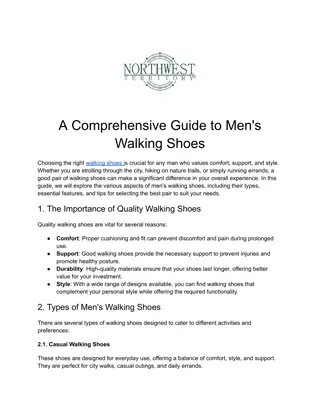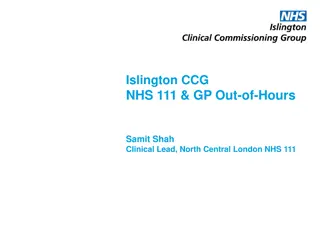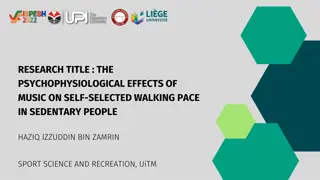Reusing Walking Aids for a Greener NHS
Reusing walking aids like crutches, frames, and walking sticks can significantly reduce carbon emissions and waste in the healthcare sector. By implementing walking aid reuse schemes, hospitals can save money, reduce their environmental impact, and contribute to the NHS's sustainability goals. This guide provides insights on the business case, benefits, roadmap, and steps to set up a successful walking aid reuse scheme in healthcare organizations.
Download Presentation

Please find below an Image/Link to download the presentation.
The content on the website is provided AS IS for your information and personal use only. It may not be sold, licensed, or shared on other websites without obtaining consent from the author. Download presentation by click this link. If you encounter any issues during the download, it is possible that the publisher has removed the file from their server.
E N D
Presentation Transcript
HOW-TO GUIDE EQUIPMENT RE-USE WALKING AIDS 1 | For a Greener NHS
The Business Case Many medical devices (e.g. walking aids) are durable products whose useful life greatly exceeds use by a single patient, and can be refurbished and reused repeatedly, reducing waste to landfill and avoiding carbon associated with new products. Reuse schemes have tended to be limited due to concerns around liabilities, limited resource available to set up a scheme, and the perceived low cost benefit. Over the next 3 years the NHS could reduce its carbon emissions by 7.4kt, equivalent to 281,397 car trips from London to Bristol. Why Reuse Device reuse and refurbishment could save the NHS 202 kt CO2e or 1.4% of supply chain emissions. Crutches, frames and walking sticks are in the top 20 of medical device / equipment categories for carbon footprint due to the high Green House Gas intensity of aluminium manufacture. Revenue and savings Hospitals can save up to 46,000 a year by receiving returned walking aids to be cleaned and refurbished for use by future patients. Roadmap Reuse Liability and risk Case study example Mid-Essex Hospitals Trust s achieved a 40% return rate at its pilot site and expanded to a second hospital. 3,000 items worth 27k are reused each year, plus the Trust generates income from scrap metal from damaged items. Walking Aids reuse schemes are low risk for infection control and defects. NHS Resolution's Liabilities to Third Parties Scheme provides indemnity (see slide 9 for more information) Portfolio Reuse Greener NHS ambition The Net Zero report set a target for 40% reuse of walking aids by 2025, which will contribute to Green Plan delivery for Trusts. Studies Case Ease of implementation Schemes can be in-house taking 5-10 mins to check/clean/repair each item or third-party managed collections, via drop off bins or amnesty campaigns. Additional Guidance 2 | For a Greener NHS
How to set up a walking aid reuse scheme Walking aid reuse schemes set up a process for items to be returned, cleaned, and assessed prior to being redistributed to a new patient Additional Guidance Why Reuse Case Studies, legal guidance, example delivery models and standardised project methodology examples are provided in the Additional Guidance section to assist implementation. Roadmap Reuse If you need more support, please contact the NHSEISustainable Procurement team england.ptomsustainability@nhs.net Crutches Walking sticks Walking frames Portfolio Reuse Define returns approach Develop procedures and training Consult and investigate Allocate resources Communicate to end users Studies Case Use in-house staff to manage inspect, clean and repair; or store and transfer collected items to a third- party provider to manage refurbishment offsite. Provide storage, refurbishment space and collection bins. Consult stakeholders. Some reuse may already occur. Existing practice provides a baseline and facilitates initial discussions with key stakeholders. Establish a simple returns approach and locations (hospital, Council recycling centres) via drop off bins or amnesty campaigns. Develop Standard Operating Procedures (SOP) for checking, cleaning and repairing items in-house or provision to third-party. Train all staff involved in the movement of items. Provide simple, clear notice of return locations to end users e.g. equipment labels, and inform patient contact points such as reception, ambulance staff and community nurses. Additional Guidance 3 | For a Greener NHS
What delivery models exist? There are several possible delivery models to evaluate as part of your planning process; an individual Trust may deliver a programme locally, an ICS deliver may deliver regionally or you may outsource to a third-party Why Reuse Third-party outsourcing Regional co-ordination Individual Trust Programme ownership at individual organisation level with supporting guidance from the centre (see case study) Outsourced to third party (incl. VCSEs*) with ownership and governance at central level (see case study) Regional co-ordination through ICS community. Options on contracting approach Roadmap Reuse Understanding of local / regional dependencies and requirements More product circulating in region Consistent approach for patients and increased drop off locations Early adopters encourage wider take up Leverage existing experience within the private sector Logistics and workforce provided Established performance reporting system Understanding of local / regional dependencies and requirements Items continue to circulate locally Benefits Portfolio Reuse More stakeholder engagement required initially Reduced control and oversight of progress Potential need for additional logistics set up across region Reduced control and oversight of progress Reduced savings Lack of Trust engagement could slow down the programme Multiple programmes across a region may duplicate effort Drawbacks Studies Case Additional Hybrid Approach: Additional benefits can be realised through the blending of delivery models. For example, a regional ICS co-ordinated approach could engage a third-party to minimise administrative requirements and use existing logistic networks, inventory management systems, cleaning and storage facilities. Guidance 4 | For a Greener NHS
Key Stakeholders A walking aid reuse scheme will establish a solution to return, clean and assess items prior to being redistributed to another patient Why Reuse Roadmap Reuse Clinicians, Physiotherapists, Occupational Therapists, A&E Sustainability & Procurement managers Peripheral Stores, Porters, Waste Teams End User Contact Points Portfolio Reuse Teams whose budgets are affected. A Walking Aid reuse scheme can support broader sustainability programme ambitions. Staff involved in stock management, ordering, storage and transfer (and reuse activity for inhouse schemes). Joint development of procedures and training. Reception contact points for general patient queries Staff that issue patients with equipment and need to support approaches to equipment tracking, and assurance of appropriate procedures for quality control. Ambulance abandoned patient equipment Third party collection contracts may be available through CCGs or Local Authority Social Care teams. Studies Case Community Nurses patient visits Care Homes long-term users, including higher cost items Additional Guidance 5 | For a Greener NHS
Additional Guidance Case studies Liability and risk assessment Delivery models Project methodology examples 6 | For a Greener NHS
In-house reuse programme Mid Essex Hospital Trust achieved a 40% return rate through its Walking Aids reuse programme, which involves staff inspecting, cleaning and repairing equipment onsite, saving around 25,000. Why Reuse Organisation Mid and South Essex NHS Foundation Hospital Trust Broomfield hospital with over 800 beds and over 6,000 employees treats a variety of injuries and conditions. In a year they spent 60K on walking aids ( 24K on walking frames and 36K on crutches), mainly issued through the Therapies Department, who established and coordinated the reuse scheme. Issue Roadmap Reuse An equipment return area was established in reception, staff then transfer items to a designated room for cleaning and assessment. A member of staff pairs, inspects them for functionality and faults, cleans them following local agreed SOP, and replaces worn feet bungs. Any walking aids that fail the checks are treated as waste and allocated for metal recycling. Action Portfolio Reuse Around 40 walking aids are reused each week 21% of crutches and 61% of frames are returned Reusing more than 3,000 pieces of equipment and saving around 27,000 per year The refurbishment process is quick and easy, taking one person around 5-10 minutes per walking aid. Impact Studies Case The reuse scheme needs a clear owner and coordinator A dedicated room is needed to inspect and recondition equipment along with a member of staff supporting this work ~5 hrs/wk (it is not a resource intensive activity) A set and agreed procedures to follow simplifies the task and ensures appropriate checks are completed. Communicating a simple returns approach to patients is important for success (the team used labels on equipment to encourage patients to return items) Additional Guidance Lessons learned 7 | For a Greener NHS
Third-Party Outsourcing Third-party equipment providers can collect and prepare items for reuse, with many Trusts using them to manage reuse schemes, providing waste and carbon reductions and financial savings. Why Reuse Organisation Medequip Medequip works with local councils and commissioning groups across the UK, supplying equipment ranging from simple walking aids through to sophisticated bed packages. Health authorities and councils spend some 207m in a year on Community Equipment Services. Around 2 million of the 3.5 million items loaned to patients are returned. Issue National Association of Equipment Providers (NAEP) Roadmap Reuse Medequip collects loaned equipment from designated addresses using 'dual capacity' vehicles, with separate doors and areas for clean and dirty items and antibacterial linings, maximising logistics capabilities and reducing journey numbers. Each item has a unique barcode to track it across the system, manage stock in line with anticipated requirements and providing the customer with returns data. Used equipment is assessed and prepared for reuse, or recycling and salvage of spares where the whole item cannot be reused. NAEP is a membership body that supports equipment providers and equipment services. They can provide details of suppliers offering services. Action Portfolio Reuse See more information on NAEP here. Medequip developed its Return, Reuse, Recycle campaign in partnership with West Suffolk NHS Trust, increasing rates of return significantly and rolling the approach out in other areas. Some 77% of West Suffolk's equipment is successfully returned (higher than the 55% national average) of which 91% is reused. More detail on the Medequip process can be found here. Studies Case Impact Additional Guidance The general public need to be made aware of the importance of returning these items. It needs to be easy to arrange a collection and equipment return locations need to be easily accessible. Lessons learned 8 | For a Greener NHS
Liability and risk assessment Liability for defects can arise for manufacturers, importers or Trusts. The risk for a walking aid reuse scheme is low and should not be a barrier to implementing a scheme when balanced against the significant environmental, health and cost benefits savings. Potential Liabilities Trusts can mitigate the risk by... Liability depends on specific circumstances Why Reuse Strict Product Liability: The Consumer Protection Act 1987 (CPA), liability for damage caused by a defective product. Only issue devices intended for reuse (NHS Supply catalogue crutches: NHS SC - GTB1817) Implement a quality and safety assurance programme with procedures to safely inspect, recondition, repair (minor) and set limits of reuse Is the aid authorised for reuse? Have any conditions and instructions for re-use, maintenance and/or repair been followed? Negligence: A claimant who has suffered personal injury as a result of a defect may bring a common law action for negligence against the manufacturer and/or the Trust. Roadmap Reuse Ensure indemnity/insurance is in place e.g. NHS Resolution's Liabilities to Third Parties Scheme, contact generalenquiries@resolution.nhs.uk Did the defect arise through manufacture or supply to the Trust, or did it arise through the reconditioning/repair process? Contracts: may manage the liability between the parties and indemnify each other against potential liabilities. Avoid being seen as a producer of the walking aids by only reusing aids that require minor reconditioning, and avoid white label partnerships Portfolio Reuse Maintain an inventory of manufacturers/suppliers of aids issued, a log of inspections, reconditioning, repairs and re-issue Regulatory: Product safety is regulated and can result in legal action. In most cases the Medical Devices Regulations 2002 (MDR) will apply to Walking Aids. The General Product Safety Regulations 2005 (GPSR) may apply more broadly to products intended for consumer use. Ensure the patient is provided with sufficient information, guidance and support on safe use and risks arising from use Studies Case Provide and record written guidance and instruction/ demonstration given to patients on the safe use of walking aids and reporting and dealing with any issues. If a patient is injured, establish whether the patient s own negligence (e.g. inappropriate use) or voluntary assumption of risk (e.g. Risks known to the patient) contributed to the injury. Additional Guidance Report any adverse incidents to MHRA Yellow Card NHS Resolution have stated a Trust/ICS with appropriate indemnity insurance will be covered for a walking aid re-use scheme. 9 | For a Greener NHS
Delivery models | Walking Aid amnesties A walking aid amnesty is a useful starting point in establishing reuse and can be used to test capability and processes, particularly for an in- house reuse programme in your Trust/ICS. Why Reuse Walking aid amnesty at QEH What is a walking aid amnesty? A one-off or periodic campaign to encourage patients to return items after use. An amnesty allows any patient, their relatives or friends to return items that are no longer used. They can then be inspected and refurbished as needed and made available for re-issue to patients. The Queen Elizabeth Hospital King s Lynn ran an amnesty on walking aid equipment to recover items such as crutches and walking frames. West Suffolk NHS Foundation Trust's amnesty campaign resulted in 8,500 items worth around 800,000 returned. More information can be found here. Roadmap Reuse Rehabilitation Services Manager Nigel Tarratt said: When patients are discharged from hospital they are often given items of equipment to help with their recovery. This could be something straightforward such as a walking aid or crutches. Where to start Portfolio Identify potential partners: Understand whether there are any local suppliers or equipment providers with whom you might wish to partner to support collection and storage of mobility aids Reuse Set up logistics / infrastructure: Purchase cage / bins for collecting items and decide where to locate them. For example, George Eliot Hospital Trust set up an amnesty cage outside the hospital s Rehabilitation Entrance so people did not have to enter the hospital to reduce the risk of COVID-19 transmission . If patients and their families fail to return the equipment when it is no longer needed we do our best to recover it. Very often it cannot be found because it has been put away out of sight. Studies Case Standard Operating Procedure (SOP) for cleaning and assessment: Set up an SOP for infection control prevention A drop-off point was set up in the Rehabilitation entrance at the hospital to enable easy returns. More information can be found here. Additional Guidance Refer to MHRA Guidance on managing medical devices and the approach to maintenance, repair and decontamination to determine the best delivery model for your Trust/ICS 10 | For a Greener NHS
Delivery models | In-house Model An inhouse model can be more cost effective, using quick and simple refurbishment processes that follow a Standard Operating Procedure agreed locally with clinicians and therapists. Why Reuse Lessons Learned What does an inhouse approach involve? An in-house approach uses internal staff and facilities to complete all aspects of the refurbishment process, from inspection, cleaning and completing minor repairs, to tracking, monitoring, collection, storage and movement of items. The process is simple and quick, taking 5 10 minutes per item. Establish a clear owner and coordinator for the programme Roadmap Allocate a room for the reconditioning to be carried out and a member of staff to support this (it is not a resource intensive activity) Reuse Where to start Identify programme owner: The programme owner will provide project sponsorship Set and agree processes (SOP) to follow Set up refurbishment room: Establish a dedicated area with sufficient space for inspecting, cleaning and repairing items, and storage space to clearly separate dirty returned items and clean items ready for reissue. Portfolio Reuse Communicate with users (i.e. add stickers to encourage the return of devices) SOP for cleaning and assessment: Set up a standard operating procedure (SOP) that includes infection prevention control, documented approval for products to be used and an escalation process. Equipment tracking needs to be quick and simple to encourage participation by time pressurised teams Studies Case Order supporting equipment: storage cages or bins for collection, replacement parts, labels to mark equipment as 'on loan' and identify returns location or contact, any other communication materials and disinfecting cleaning products. Focus on ease of implementation by staff and improving returns over tracking individual items Measuring progress: Agree a standard set of KPIs and establish monitoring processes for measuring progress. See the monitoring and reporting examples. Additional Guidance Performance data can be provided by third party providers. Staff Training: Train all staff in infection control, and portering staff in the process 11 | For a Greener NHS
Delivery models | Third party enabled solution An outsourced model reduces administrative requirements for the Trust/ICS and provides wider access to patients looking to return items. Schemes that do not return items to the Trust/ICS for re-issues may not deliver savings to the Trust/ICS. A third party enabled solution provides experience of rolling out a reuse programme. The solution might include: Fully outsourced model to third party: Engage with a third party who provide a managed service for community equipment. If unsure where to start, The National Association of Equipment Providers (NAEP) is a membership body for providers of equipment and services. Use of VCSE*, providing a level of social value: Explore whether any local VCSE organisations provide take back or reuse services, for example British Red Cross Collaboration across the region with third party (private sector or VCSE): Blended model harnessing the benefits of Regional / ICS delivery and Third party enabled delivery Why Reuse VCSE take back schemes There are a number of voluntary, community and social enterprise organisations who provide take back schemes, both locally and nationally. Roadmap Reuse Where to start Identify potential partners: Understand existing contracts and relationships through SCCL or your local area, as well as potential other third parties who might be suitable to partner with SOP for cleaning and assessment: Work with the third party to set up a SOP for your programme that follows local IPC and decontamination policy. They might already have standard procedures from similar schemes Measuring progress: Agree a standard set of KPIs and process for measuring progress. See the monitoring and reporting examples. Portfolio Reuse For example, Warrington Disability Partnership runs a mobility equipment recycling scheme. The scheme recovers, recycles and reuses electric mobility scooters and wheelchairs, manual wheelchairs, crutches, wheeled and framed walkers. Donated equipment, once restored, is used in their Shopmobility fleet and independent living equipment loan services. Surplus goods are sold on at affordable prices from their Shopmobility service. Studies Case Additional Guidance 12 | For a Greener NHS
Delivery models | ICS/Regional Co-ordination Aggregating contracts or procurement approaches from across your ICS/region could enhance the benefits of your programme Regions can have a variety of separate contracts and logistics operations for walking aids with a mix of in-house operations and outsourced. Fragmented service delivery is likely to incur higher costs than delivery at scale. Warehousing, cleaning, monitoring systems and other support contracts could be consolidated under a regional model. Why Reuse Regional models Description Benefits Drawbacks Implement a central procurement function and single IT system across the non- outsourced providers No change to outsourced contracts Common platform across in-house providers Lower one off and recurring costs Short time to deliver (est. 3-6 months) Limited regional collaboration Roadmap Reuse Integrated model across the non- outsourced providers delivered by one service provider No change to outsourced contracts Portfolio Longer time to deliver (est. 14-17 months) Lower net benefit compared to #3 Limited regional collaboration Reuse Consolidated operating model with in-house providers Potential for high recurring and one-off benefits Studies Case A regional model would provide a consistent service for users through a consolidated operating platform. Fully integrated single operating model across the region delivered by one service provider Potential for high recurring and one-off benefits Full regional collaboration Single consolidated operating model across the region Longer time to deliver (est. 17 20 months) Additional Guidance 13 | For a Greener NHS
Examples | Workflow map CLEAN & RESTOCK RETURN & RECOLLECTION PATIENT CARE Why Reuse Patient receives a walking aid device to be used while patient remains on the ward Patient is assessed for need of walking aid following discharge Ward equipment is returned, and take-home walking aid ordered for patient HIGH-LEVEL DESCRIPTION Roadmap Reuse Does the equipment provider collect sub-stores equipment i.e. equipment not delivered? Patient assessed for on-going need of walking aid. Where the patient requires an aid following discharge, the therapy team orders equipment for discharge from the equipment service provided by the relevant local authority Identifies the patient needs a walking aid: walking stick, elbow crutch, zimmer frame, or rollator frame THERAPIST Stock not collected or returned assumed to be disposed of (i.e. waste) Receives walking aid from equipment provider or, if discharge imminent, provided by the ward sub-stores Receives equipment from the ward. Where possible, relatives were previously encouraged to bring the patient s own aid to the ward, but with visiting restrictions and increased IPC guidelines this has not happened for the past 12 months) Portfolio Reuse Provided with telephone number and advised to contact equipment provider to arrange collection. PATIENTS How is this ward stock managed? Who is responsible for it? Who is responsible for the sub- store stock? Walking aid checked for damage, general wear and tear. If none, cleaned with soapy water/ low level disinfectant and re-stocked Walking aid provided from ward stock. Walking aid provided from sub-stores Ward equipment returned Studies WARD Case What happens to this equipment? What happens to returned ward equipment from in-patients? What quality control checks are in place? Does the equipment provider replenish sub- stores stock? Deliver walking aid to patient s home address Replenish ward sub- stores Collects equipment from Patient EQUIPMENT PROVIDER Additional Guidance 14 | For a Greener NHS
Examples | Roles & responsibilities* Define required roles and responsibilities within the Trust/ICS and at a committee level, including oversight of procedural documents, compliance with decontamination guidance and cleaning standards audit results R O L E R E S P O N S I B I L I T I E S Why Reuse Overall responsibility for ensuring the Trust has robust and up to dateprocedural documents in place to govern and guide activities Chief Executive Ensure all procedural documents under their remit are appropriate, up to date and available at the point of need Executive Directors Roadmap Reuse Overseeing progress on all procedural documents and reviewing and taking action where appropriate in relation to updates received from the procedural document group. Director of Nursing Musculoskeletal (MSK) Directorate Committee Meeting Ensure their procedural documents are reviewed in a timely manner. Portfolio Reuse Musculoskeletal (MSK) Managers Support the dissemination and implementation of new / revised procedural documents. Responsible for familiarising themselves with this procedural document and co-operating with the development and implementation of all procedural documents as part of their normal duties and responsibilities. All Musculoskeletal (MSK) Staff Studies Case All staff have a duty to maintain a clean environment. Those assisting with walking aid cleans must follow the provided flowchart. All Staff Musculoskeletal (MSK) Clinical Governance: Ensure procedural documents are updated and reviewed within the required timeline. Additional Guidance Lead on the development or major review of a procedural document. The author must also provide a brief summary for staff communication / launching purposes. All procedural documents must have an equality impact assessment. Author 15 | For a Greener NHS *Example from Mid-Essex Hospital Trust
Examples | Cleaning and checking procedure Below is a basic example cleaning and checking procedure based on case studies and supplier guidance of not for single use aids Returns moved to storage Assess wheels, screws, springs Assess item for stress Assess extension Assess grips Why Reuse Assess any wheels for cracks. Conduct tests for ease of wheel rotation, brakes lock and unlock, screws/bolts are tight, adjusting springs move easily and fixings are secured Visual check for wear, damage, rust, stress or cracks. Apply weight and twist the frame to check rigidity and strength Assess for deformed, worn, torn or missing grips, handles or pads. Apply weight to test stability and tightness of grips/handles Returned walking aids moved to cleaning and assessment room. Assess crutches as a pair. Fully extend the aid to reveal the whole shaft, test all buttoned extensions for easy adjustment Roadmap Reuse Fail Pass Aid issued to patient for reuse Portfolio Reuse One or more checks failed, place aid in the metal recycling collection area. If one crutch fails, dispose of as a pair. Record failed items. All checks passed. Walking aid is suitable for re-use. Record the result and return to stock Clean items Replace parts and label Studies Case Check ferrules and fixings. Replace worn parts or that are not secure or flush to the floor. Add a new returns label (centre of frame rail or shaft of crutch). Clean the whole extended shaft and handles and use a suitable low-level disinfectant. Record walking aids passed for re-issue and cleaned to a designated re-issue area Additional Guidance 16 | For a Greener NHS
Examples | Training requirements Create SOP for assessing items and the decontamination process and training materials that address the technical skills and knowledge requirements Why Reuse Training Requirements Infection prevention control learning - mandatory for all staff Process and criteria training for new portering staff Infection prevention control Roadmap Walking aids are low risk commonly coming into contact with intact healthy skin and are non-clinical in nature. Reuse A reusable cloth (where validated laundry process is available) or wipes for cleaning to remove organic matter and the use of a low-level disinfectant suitable for the equipment according to local trust IPC and decontamination policy is considered a suitable decontamination method. Refer to the National Standards of Healthcare Cleanliness 2021 and your local Infection Prevention Control lead for further guidance. Portfolio Reuse Level of Decontamination Category Indication Examples Method Wash with warm water and neutral detergent and dry thoroughly or use reusable cloth and suitable low-level disinfectant (following manufacturers guidance on compatibility, contact and drying times) Studies Case Washbowls, mattresses Low Risk Items used on intact skin clean Additional Guidance 17 | For a Greener NHS
Examples | Monitoring and reporting Collecting and periodically analysing data from the programme is vital in order to understand success and areas for improvement A log sheet and accompanying spreadsheet should be used to measure and track the volume of walking aids returned and reused as well as the accompanying financial benefits. The data should be monitored and evaluated periodically in order to identify opportunities for further improvement. The log sheet should look to include information on items returned, refurbished and disposed, as well as monitor any replacement parts and their stock levels. For example: Why Reuse Crutches refurbished (pairs) Crutches disposed of (pairs) [Other items] refurbished (pairs) [Other items] disposed of (pairs) Number of ferrules used (single) Crutches returned (pairs) [Other items] returned (pairs) Date Roadmap Reuse This log sheet can then be used to monitor the percentage of items refurbished, volume of waste avoided and carbon savings. Other example success measures include: Total saved on walking aids (per category) % return rate of walking aids Patient satisfaction with refurbished walking aid Refurbishment time Portfolio Reuse Measuring carbon and waste impact Collecting the right data will enable you to calculate your impact on cost, waste and carbon. Example metrics: Total savings from refurbished items: Cost savings from not needing to repurchase items Carbon savings from refurbished items: kgCO2e diverted by not needing to repurchase items % Refurbished instead of disposed of: Ratio of returned items refurbished versus disposed of (due to wear and tear) Waste collections saved: Average waste collections per tonne multiplied by total weight refurbished Waste savings per tonne: Cost per tonne multiplied by volume avoided Studies Case Additional Guidance 18 | For a Greener NHS
